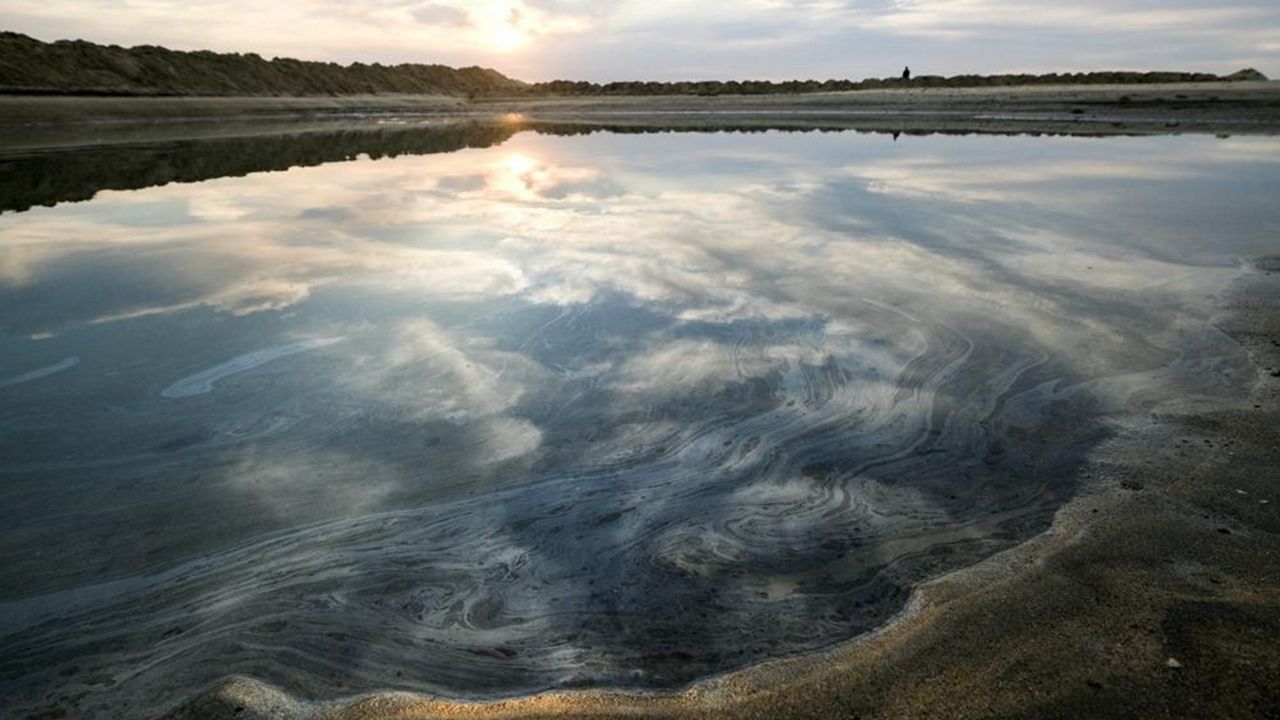HUNTINGTON BEACH, Calif. (AP) — The Coast Guard received the first report of a possible oil spill off the Southern California coast more than 12 hours before a company reported a major leak in its pipeline and a cleanup effort was launched, records show.
Oil spill reports reviewed Monday by The Associated Press raise questions about the Coast Guard’s response to one of the state’s largest recent spills and about how quickly Amplify Energy, the company operating three offshore platforms and the pipeline, recognized it had a problem and notified authorities.
Two early calls about the spill came into the National Response Center, which is staffed by the Coast Guard and notifies other agencies of disasters for quick response. The first was from an anchored ship that noticed a sheen on the water. The second came six hours later from a federal agency that said a possible oil slick was spotted on satellite imagery, according to reports by the California Office of Emergency Services.
The spill sent up to 126,000 gallons (572,807 liters) of heavy crude into the ocean off Huntington Beach, and it then washed onto miles of beaches and a protected marshland. The beaches could remain closed for weeks or longer, a major hit to the local economy. Coastal fisheries in the area are closed to commercial and recreational fishing.
Federal and state authorities require rapid reporting of a spill. Failure to do so has led to criminal prosecutions of companies, including Plains All American Pipeline, which caused a coastal spill near Santa Barbara in 2015, and Southern California Gas Co. for a massive well blowout later that year.
Meanwhile, Coast Guard officials said Monday that investigators were looking into whether a ship’s anchor may have struck a pipeline on the ocean floor.
Amplify Energy CEO Martyn Willsher said company divers were inspecting the area of the suspected leak reported Saturday, and he expected that by Tuesday there would be a clearer picture of what caused the damage. Willsher said an anchor from a cargo ship striking the pipeline is “one of the distinct possibilities” behind the leak.
Cargo ships entering the twin ports of Los Angeles and Long Beach routinely pass through the area. Backlogs have plagued the ports in recent months, and several dozen or more of the giant vessels have regularly been anchored as they wait to enter the ports and unload.
Signs were posted Tuesday in Huntington Beach declaring that the beach was open but the ocean and shore were closed. On a typical day, surfers would usually be seen bobbing in the waves but not now. Huntington State Beach still had an oily smell, although it was less severe than the stench emanating from the water on Sunday.
Experts say it’s too early to determine the spill’s full impact on the environment, but so far the number of animals found harmed is minimal.
David Pettit, senior attorney for Natural Resources Defense Council who worked on the Deepwater Horizon response and other spills, said damage assessment will require biologists to study multiple factors.
“There’s going to be huge response costs the company will be liable for,” he said. “At some point, the incident commanders are going to give the guilty party a paper with a bill on it.”
Pettit said many local businesses will have claims against the company for loss of resources, including loss of beach use by residents. “There are people who can put an economic value on this, and you multiply it by the number of people who would have gone but didn’t,” he said.
Coast Guard Lt. Cmdr. Jeannie Shaye said the Coast Guard was not notified of the disaster until Saturday morning, though records show its hazardous spill response hotline received the first report of a possible oil slick Friday evening.
A foreign ship anchored off the coast witnessed an “unknown sheen in the water near their vessel” at 6:13 p.m. and the report was called into the response center just after 8:22 p.m., according to the state report.
Lonnie Harrison Jr., vice president of Colonial Compliance Systems Inc., which works with foreign ships in U.S. waters to report spills, said one its clients reported the sighting.
Harrison, a retired Coast Guard captain, said the ship was not involved in the spill and was later given clearance over the weekend to enter the port to refuel after determining it was not contaminated by the slick.
About six hours after the first report was received, the National Oceanic and Atmospheric Administration reported that satellite imagery spotted a possible oil slick more than 3 miles (5 kilometers) long. The report by the National Response Center said the image of a “possible oil anomaly” was probably associated with the first report.
“Although there were numerous vessels within immediate proximity to the anomaly, none were clearly associated with the anomaly,” the report said. “These factors prevented the possible identification of a point source.”
The company that operates the pipeline first reported the spill to the Coast Guard’s response center at 8:55 a.m. Saturday. However, the report said the incident occurred at 2:30 a.m.
A 2016 spill response plan for the Amplify platforms submitted to federal regulators called for immediate notification of federal officials when more than one barrel of oil is released into the water. Releases greater than five barrels — or that threaten state waters or the shoreline — require immediate notification of the state fire marshal and California wildlife officials.
The pipeline was supposed to be monitored under an automated leak detection system that would report problems to a control room staffed around the clock on the oil platform known as Elly.
The system was designed to trigger an alarm whenever a change in the flow of oil is detected. But how fast it can pick up on those changes was expected to vary according to the size of the leak. For a large leak — 10% or more of the amount of oil flowing through the pipeline — the detection time was estimated at five minutes. Smaller leaks were expected to take up to 50 minutes to detect, according to the response plan.
The spill plan warned that a break in the pipeline could cause “substantial harm to the environment” and that in a worst-case scenario 3,111 barrels (131,000 gallons) of oil could be released from the pipeline.
Willsher said required agencies were notified “instantly” when the company recognized the leak was from its pipe. Records show the spill was not reported by Amplify Energy, but by Witt O’Brien’s, a crisis and emergency management firm listed on the spill response plan as the point of contact to notify the NRC.
The report said the leaking pipe had been shut off, but containment was not confirmed.
Potential criminal investigations were being pursued by the Orange County district attorney, the U.S. Department of Justice, the Coast Guard and the California Department of Fish and Wildlife, officials said.
Safety advocates have pushed for years for federal rules that would strengthen oil spill detection requirements and force companies to install valves that can automatically shut down the flow of crude in case of a leak. The oil and pipeline industries have resisted such requirements because of the high cost.










